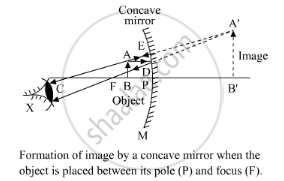Advertisements
Advertisements
Question
Draw ray-diagrams to show the formation of images when the object is places in front of a concave mirror (converging mirror):
(i) between its pole and focus
(ii) between its centre of curvature and focus
Solution
When an object is placed between the pole and the focus of a concave mirror, the image formed is virtual, erect, magnified and behind the mirror. This is illustrated as follows:

Here, the image A'B' of the object AB, placed between the pole and the focus of a concave mirror, is virtual and erect.
APPEARS IN
RELATED QUESTIONS
If the focal length of a convex mirror is 25 cm, what is its radius of curvature?
With the help of a labelled ray diagram, describe how a converging mirror can be used to give an enlarged upright image of an object.
According to the "New Cartesian Singh Convention" for mirrors, what sign has been given to the focal length of:
a convex mirror?
Giving reasons, state the 'signs' (positive or negative) which can be given to the following:
(a) object distance (u) for a concave mirror or convex mirror
(b) image distance (v) for a concave mirror
(c) image distance (v) for a convex mirror
A large concave mirror has a radius of curvature of 1.5 m. A person stands 10 m in front of the mirror. Where is the person's image?
What type of mirror should be used as a shaving mirror?
A student has focused the image of a candle flame on a white screen using a concave mirror. The situation is as given below:
Length of the flame = 1.5 cm
Distance of flame from the mirror = 18 cm
If the flame is perpendicular to the principal axis of the mirror, then calculate the following:
- Distance of the image from the mirror
- Length of the image
If the distance between the mirror and the flame is reduced to 10 cm, then what would be observed on the screen? Draw ray diagram to justify your answer for this situation.
Answer the following question:
An object is placed at a distance of 30 cm from a concave lens of focal length 30 cm.
(i) Use the lens formula to determine the distance of the image from the lens.
(ii) List four characteristics of the image (nature, position, size, erect/inverted) in this case.
(iii) Draw a labelled diagram to justify your answer of the part (ii)
You are provided with a convex mirror, a concave mirror, a convex lens and a concave lens. You can get an inverted image from
______ mirrors make things look larger when objects are placed close to them.
